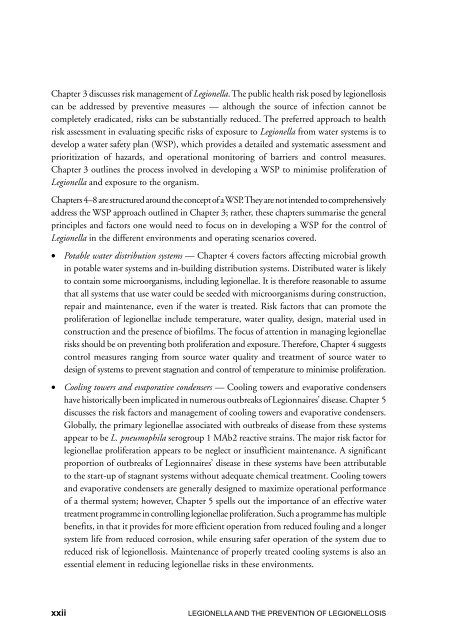LEGIONELLA - World Health Organization
LEGIONELLA - World Health Organization
LEGIONELLA - World Health Organization
You also want an ePaper? Increase the reach of your titles
YUMPU automatically turns print PDFs into web optimized ePapers that Google loves.
Chapter 3 discusses risk management of Legionella. The public health risk posed by legionellosis<br />
can be addressed by preventive measures — although the source of infection cannot be<br />
completely eradicated, risks can be substantially reduced. The preferred approach to health<br />
risk assessment in evaluating specific risks of exposure to Legionella from water systems is to<br />
develop a water safety plan (WSP), which provides a detailed and systematic assessment and<br />
prioritization of hazards, and operational monitoring of barriers and control measures.<br />
Chapter 3 outlines the process involved in developing a WSP to minimise proliferation of<br />
Legionella and exposure to the organism.<br />
Chapters 4–8 are structured around the concept of a WSP. They are not intended to comprehensively<br />
address the WSP approach outlined in Chapter 3; rather, these chapters summarise the general<br />
principles and factors one would need to focus on in developing a WSP for the control of<br />
Legionella in the different environments and operating scenarios covered.<br />
• Potable water distribution systems — Chapter 4 covers factors affecting microbial growth<br />
in potable water systems and in-building distribution systems. Distributed water is likely<br />
to contain some microorganisms, including legionellae. It is therefore reasonable to assume<br />
that all systems that use water could be seeded with microorganisms during construction,<br />
repair and maintenance, even if the water is treated. Risk factors that can promote the<br />
proliferation of legionellae include temperature, water quality, design, material used in<br />
construction and the presence of biofilms. The focus of attention in managing legionellae<br />
risks should be on preventing both proliferation and exposure. Therefore, Chapter 4 suggests<br />
control measures ranging from source water quality and treatment of source water to<br />
design of systems to prevent stagnation and control of temperature to minimise proliferation.<br />
• Cooling towers and evaporative condensers — Cooling towers and evaporative condensers<br />
have historically been implicated in numerous outbreaks of Legionnaires’ disease. Chapter 5<br />
discusses the risk factors and management of cooling towers and evaporative condensers.<br />
Globally, the primary legionellae associated with outbreaks of disease from these systems<br />
appear to be L. pneumophila serogroup 1 MAb2 reactive strains. The major risk factor for<br />
legionellae proliferation appears to be neglect or insufficient maintenance. A significant<br />
proportion of outbreaks of Legionnaires’ disease in these systems have been attributable<br />
to the start-up of stagnant systems without adequate chemical treatment. Cooling towers<br />
and evaporative condensers are generally designed to maximize operational performance<br />
of a thermal system; however, Chapter 5 spells out the importance of an effective water<br />
treatment programme in controlling legionellae proliferation. Such a programme has multiple<br />
benefits, in that it provides for more efficient operation from reduced fouling and a longer<br />
system life from reduced corrosion, while ensuring safer operation of the system due to<br />
reduced risk of legionellosis. Maintenance of properly treated cooling systems is also an<br />
essential element in reducing legionellae risks in these environments.<br />
xx <strong>LEGIONELLA</strong> AND THE PREVENTION OF LEGIONELLOSIS

















